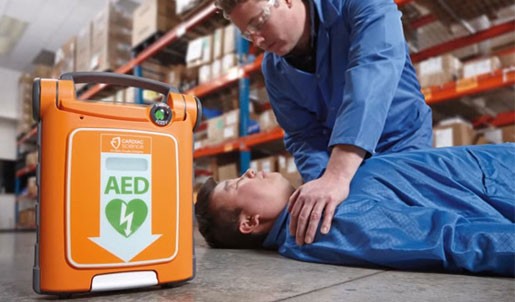In Australia, one person dies every 26-minutes from heart disease. In most cases, these deaths are sudden and unexpected, happening as a result of cardiac arrest.
Sadly, survival rates for sudden cardiac arrests (SCA) are only between two and five per cent, with survival rates dropping by a whopping ten per cent for every minute that passes. The average response time for Australian ambulances is ten to 12 minutes in metropolitan areas, and up to 30-minutes in regional areas, but when you only have a ten-minute window to act, waiting for help to arrive often proves fatal.
Can anything be done to protect the 30,000 Australians that lose their lives to SCA each year?
It can, and it’s not as difficult as you might think. The best thing you can do to protect your staff and customers in the event of a cardiac emergency is to have an up-to-date Automated External Defibrillator (AED) on-site.
An AED is a portable electronic device that can automatically diagnose sudden cardiac arrests, and treat patients by administering electrical therapy (defibrillation), which helps the heart to re-establish an effective, life-sustaining rhythm.
These devices are one of the many miracles of modern-day technology, as they significantly increase a patient’s chances of survival, and can be used by almost anyone. If an AED is not available in an emergency situation, the patient’s outlook is grim, with 94 per cent of SCA victims dying before they reach the hospital.
This is why having an AED available on-site is essential for businesses, sporting clubs and any commercial enterprises.
The Powerheart AED G5 and G3 Automatic Plus are the most popular AED’s in the corporate market, as they’re easy to use and are virtually impossible to use incorrectly.
These models take AED design and technology to a new level of reliability, as the Powerheart G5 is the first AED to combine real-time CPR feedback, fast shock times, and escalating energy for effective response to SCA .
To use a fully-automatic AED, all you need to do is open the lid and listen to the voice/text prompts, which will direct you to attach the electrode pads. The device will then determine the extent of the patient’s condition, and if needed, will deliver the shock automatically. If no shock is required, our AED models will guide you through a two-minute CPR cycle (30 compressions followed by two breaths for two minutes). There are also semi-automatic models available, where a shock button can be pressed, as required.
Despite their functionality and ease of use, one of the biggest benefits of these state-of-the-art devices is that they are maintenance free. The G3 and G5 AED will perform comprehensive self-testing of the critical components automatically, on a daily, weekly and monthly basis.
Some other product features include:
Defibrillation within the first few minutes of a cardiac arrest increases a person’s chances of survival by up to 70 per cent!
While there are thousands of stories depicting the simplicity and effectiveness of using an AED, one particular case springs to mind.
A few years ago, new mum Samantha Jobe was working out at her local gym with her husband and eight week old daughter nearby when she suddenly collapsed. The gym’s trainers initially thought she fell, but when they approached her, they realised her heart had stopped and she had no pulse. Two of the facility’s staff were quick to jump to action, alternating between CPR compressions and breaths, while the business owner’s wife rushed to a nearby chemical company, BASF, who she recalled recently talking about their purchase of a defibrillator.
BASF staff quickly rushed to the gym where they successfully shocked Samantha, reviving her pulse. When emergency services staff arrived within ten minutes, they administered a breathing tube and blood pressure medications. The on-scene paramedic said that when she arrived on-scene, she feared the worst, as people are typically considered clinically brain dead within four to five minutes. Early access to CPR and a defibrillator saved Samantha from that fate.
This case perfectly illustrates how invaluable AED technology is both at a commercial and humanistic level.
For more information about the defibrillator technology available for your business, click here or contact the team at SafetyQuip today!
*Understanding the warning signs of a cardiac arrest is a must for any Australian, as heart issues can affect people of all ages, even those in seemingly perfect health. The Australian Heart Foundation’s website is an invaluable resource that sheds light on this devastating health issue. If you’re concerned about your health and well-being, or that of those around you – talk to your doctor today.

Safety Gear - Workwear - Footwear - Site Safety
Meeting your safety obligations to your workforce is a serious business. Standards evolve, and it can be tough to keep abreast of them. So it’s great to know you have a partner in SafetyQuip – a business that makes it its business to know your safety issues, and stocks all the safety workwear and PPE you will need to address them.
At SafetyQuip, we stock every kind of safety equipment and PPE, including respiratory protection, HI VIS safety workwear, height safety and skin protection. We stock safety equipment for materials handling, with ladders, platforms and elevated work spaces. And we’ve got you covered for personal protective equipment for the feet, with waterproof and steel capped work boots, plus a range of accessories.
Read More